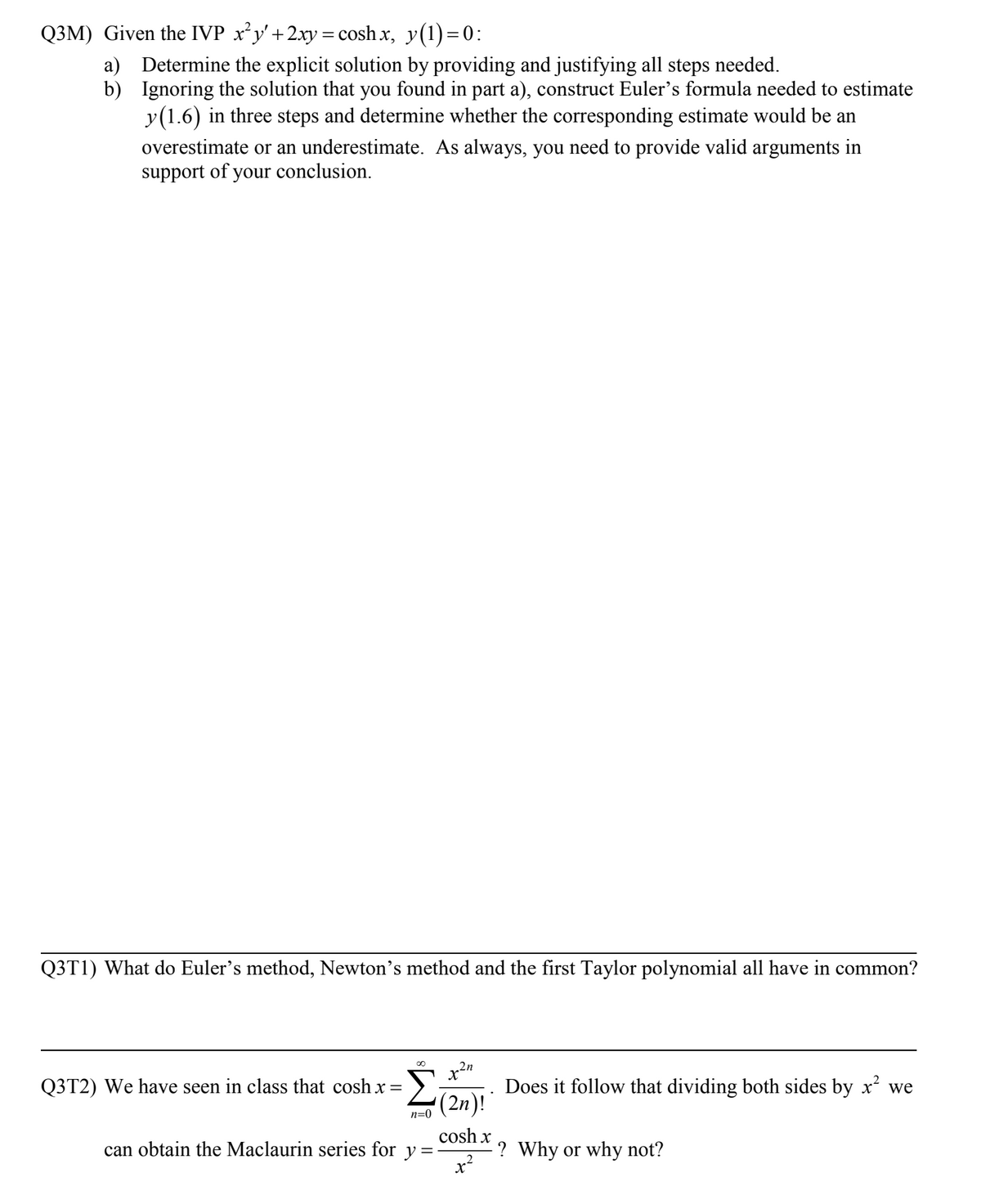Q3M) Given the IVP x²y' +2xy = cosh x, y(1)=0: a) Determine the explicit solution by providing and justifying all steps needed. b) Ignoring the solution that you found in part a), construct Euler's formula needed to estimate y(1.6) in three steps and determine whether the corresponding estimate would be an overestimate or an underestimate. As always, you need to provide valid arguments in support of your conclusion.
Q3M) Given the IVP x²y' +2xy = cosh x, y(1)=0: a) Determine the explicit solution by providing and justifying all steps needed. b) Ignoring the solution that you found in part a), construct Euler's formula needed to estimate y(1.6) in three steps and determine whether the corresponding estimate would be an overestimate or an underestimate. As always, you need to provide valid arguments in support of your conclusion.
Advanced Engineering Mathematics
10th Edition
ISBN:9780470458365
Author:Erwin Kreyszig
Publisher:Erwin Kreyszig
Chapter2: Second-order Linear Odes
Section: Chapter Questions
Problem 1RQ
Related questions
Question
100%
Pls help ASAP. Please write each step. ASAP pls. Pls help, I beg.

Transcribed Image Text:Q3M) Given the IVP xy'+2xy = cosh x, y(1)=0:
a) Determine the explicit solution by providing and justifying all steps needed.
b) Ignoring the solution that you found in part a), construct Euler's formula needed to estimate
y(1.6) in three steps and determine whether the corresponding estimate would be an
overestimate or an underestimate. As always, you need to provide valid arguments in
support of your conclusion.
Q3T1) What do Euler's method, Newton's method and the first Taylor polynomial all have in common?
2n
Q3T2) We have seen in class that cosh x =
Does it follow that dividing both sides by x' we
(2n)!
n=0
cosh x
can obtain the Maclaurin series for y =
-? Why or why not?
x²
Expert Solution
This question has been solved!
Explore an expertly crafted, step-by-step solution for a thorough understanding of key concepts.
Step by step
Solved in 8 steps

Knowledge Booster
Learn more about
Need a deep-dive on the concept behind this application? Look no further. Learn more about this topic, advanced-math and related others by exploring similar questions and additional content below.Recommended textbooks for you

Advanced Engineering Mathematics
Advanced Math
ISBN:
9780470458365
Author:
Erwin Kreyszig
Publisher:
Wiley, John & Sons, Incorporated

Numerical Methods for Engineers
Advanced Math
ISBN:
9780073397924
Author:
Steven C. Chapra Dr., Raymond P. Canale
Publisher:
McGraw-Hill Education

Introductory Mathematics for Engineering Applicat…
Advanced Math
ISBN:
9781118141809
Author:
Nathan Klingbeil
Publisher:
WILEY

Advanced Engineering Mathematics
Advanced Math
ISBN:
9780470458365
Author:
Erwin Kreyszig
Publisher:
Wiley, John & Sons, Incorporated

Numerical Methods for Engineers
Advanced Math
ISBN:
9780073397924
Author:
Steven C. Chapra Dr., Raymond P. Canale
Publisher:
McGraw-Hill Education

Introductory Mathematics for Engineering Applicat…
Advanced Math
ISBN:
9781118141809
Author:
Nathan Klingbeil
Publisher:
WILEY

Mathematics For Machine Technology
Advanced Math
ISBN:
9781337798310
Author:
Peterson, John.
Publisher:
Cengage Learning,

